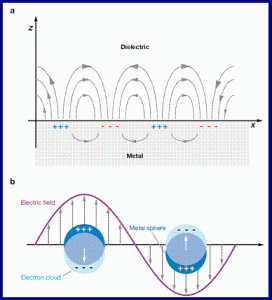
Dr Shengli Zou’s research group at University of Central Florida is currently working on research in the field of nanoparticles and their properties pertaining to light transmittance and absorption. This web page is designed to aid in understanding how materials respond to light energy changes and how that affects materials on a molecular scale.
Plasmonics
Def. The study of density waves of electrons (plasmons) that are created when light hits the surface of a metal at precise circumstances, that is, at the structure’s resonance energy level. The resonance energy corresponds to the wavelength absorption that occurs. If a band of wavelengths strike the metallic object the non-absorbed wavelengths will reflect, causing the structure to have color. ”

These surface plasmons occur at the interface of a metal and a dielectric material. The optic properties of these surface plasmons can be determined in two ways.
1. By using spectroscopy equipment in a laboratory setting.
Or
2. By using computer modeling with a program called Discrete Dipole Approximation (DDA)
Surface Plasmons
Surface plasmons (SP’s) are electromagnetic waves that propagate ( travel )at the interface between metals and dielectric (non conductive) material. This simulates the propagation of surface plasmons on Ag-air interface, the color indicates the magnitude or strength of electric field (blue for positive and red for negative). The source for SP’s is a point dipole and is placed at the center. In this simulation, you can also see strong localization of these waves at the interface. The plasmon behavior has attracted the attention of researchers in engineering, physics and chemistry communities.

Resonance frequency–def. Maximum oscillation at specific frequencies. Each size and shape nanoparticle represents a different resonance frequency. For more information about resonance these web sites may help. In the first animation when the force applied matches the maximum spring constant resonance occurs. Similarly, when the wavelength frequency matches the resonance energy maximum oscillation of the plasmons occur.
http://ngsir.netfirms.com/englishhtm/Resonance.htm
http://www.pbs.org/wgbh/nova/elegant/resonance.html